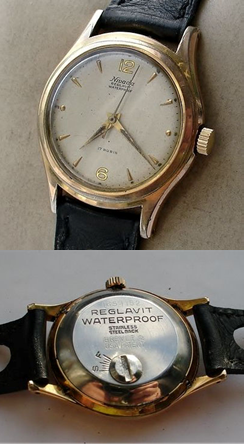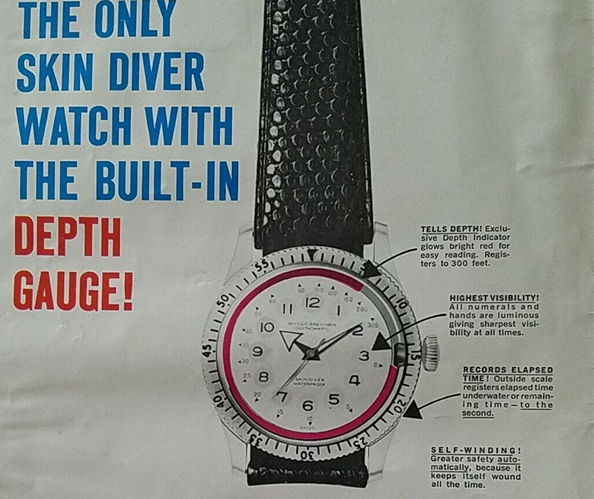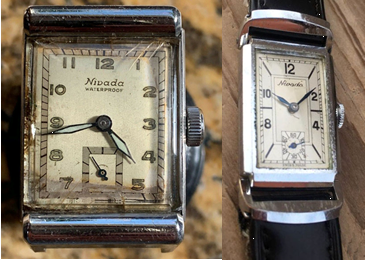By Bruce Shawkey
 |
| Chronomaster |
Mention Nivada to the average wristwatch collector, and it may not ring a bell. Mention Nivada to chronograph collectors, and most will instantly recognize the name. The Nivada Chronomaster, and all its variations, are some of the hottest selling watches on the vintage market today. They are so coveted and hard to find, that many collectors are buying the current-day re-issues of the Chronomaster on the company's website at https://nivadagrenchenofficial.com/. They are true to the originals and have modern movements, and cost less than the vintage originals to boot.
What many do not know is that Nivada has a long history, going back decades before the '60s, before most of their famous chronographs were introduced. They also enjoyed success in America with their Croton counterpart starting in about 1940. Back then, Nivada and Croton-Nivada watches were simply time only, which are overlooked by many Nivada collectors in their quest to collect only chronographs. So let's take a closer look at this Swiss company and its watches, chronographs and all.
The roots of Nivada are a mystery. Kathleen Pritchard, in her two-volume encyclopedia of Swiss watch manufacturers, states the company was founded in 1878 in Grenchen, Switzerland. However, we know almost nothing about the company's early activities. It's not uncommon to find Swiss watch companies that lay dormant for years or even decades after their founding. Often, it's the result of bad economic times, or family squabbles about who gets to run the company, or lack of sufficient funds.
Whatever the reason, the company didn't really come alive until 48 years later in 1926 when Jacob Schneider began operating the company under the name Wülliman Schneider Nivada S.A. The story goes that Swiss officials mandated that the word "Grenchen" be added on their watch dials after the signature "Nivada" so that the brand would not be confused with the similar-sounding "Movado," which had been started some years back by Achille Ditesheim. The Ditesheims were a prominent watchmaking family in Switzerland in those days and no doubt exerted influence in assuring no one would confuse Nivada with Movado. It’s apparent that enforcement of this “rule” was not consistent, as many early Nivada watches can be found without the “Grenchen” suffix, as seen below.
From the start, Schneider (or perhaps Wülliman) decided their company did not want to build its own movements, but rely on ebauches (rough movements) from ETA, Phénix, A. Schild, and others and finish them inhouse. We know little of Mr. Wülliman; it appears Schneider was the senior partner in the venture, as his son, Jacob, eventually took over the company and was running it as late as 1976.
Pritchard reports that Nivada exhibited at the 1939 Swiss National Exhibition, around the same time as it began its affiliation with Croton. Again, there are conflicting reports as to how this affiliation came about. Some say that Croton, based in New York, was already an established company. Others sources say Nivada created Croton expressly to distribute their product in America. Either way, Croton-Nivada did very well in America, right up until the quartz crisis of the '70s, especially the chronographs of the '60s. Nivada and American counterpoint Croton watches had almost identical movements, with the exception of movement markings. Watches sold in the U.S. were branded as Croton Nivada, Croton Nivada Grenchen, or simply Croton.
Early Nivada wristwatches, though not especially rare, are not especially plentiful either. A couple of examples are shown at left. The absence of “Grenchen” on the dials illustrates the inconsistency of early dial signatures. While priced reasonably, early watches from the brand nevertheless exuded class and elegance, thanks to svelte design and art deco styling cues.
Other notable models included the manual wind Buccaneer (below right ), the Alerta (also below right), an alarm watch featuring the newly developed A. Schild Caliber 1475, the Discus (marketed for its “flat, thin elegance”) and the Cape Horn.
And then there was the "Reglavit" (below) that had a screw head on the back connected to the regulator so that minor timing adjustments could be made without opening the case. I don't think it sold very well, because most people didn't understand that the screwhead was only for minor adjustments and was no substitute for cleaning when timing started going off by more than a few seconds per day. |
| Reglavit |
But Nivada/Croton really began to hit its stride when it gave the U.S. Navy team lead by Admiral Richard Byrd watches for their "Operation Deep Freeze" expedition to the South Pole from 1955 to 1956. At the time, the watches were named the "Aquamatic" model, but were quickly rebranded the "Antarctic" model to capitalize on the publicity of having survived the cold temps of the South Pole. Today, the Antarctic
is considered one of Nivada Grenchen’s signature models. Nivada hit another success when in the early '60s it rebranded the "Alerta" model to the "Wanderer," marketing it to jet-setting travelers and containing Vulcain's caliber 120 "Cricket" movement.
At this point, we’ll take a break and look at some vintage ads for Nivada and Croton watches.
 |
From a 1941 newspaper ad. Though never an official Ordnance supplier to the Defense Department, Croton nevertheless advertised its watches as suitable for servicemen. Thanks to fellow collector Jack Wood for sending me this image.
 |
| Ad for Depthomatic, circa 1960. |
Nivada's next big success was its signature Chronomaster Aviator Sea Diver, introduced in 1961 (far left). It would become the brand's most iconic model. Suitable for use on land, air, or under sea (water resistant to 200 meters), the model featured a number of movements over the years, including the Venus 210, Valjoux 92, Valjoux 23, Landeron 248, and the Valjoux 7733. It had almost anything a professional would need. The dial featured a tachymeter for measuring speed, and the totalizer dial at three o’clock could be used to count up to 30 minutes of elapsed time, or, with its red highlighter on the minutes counter, could be used to count down the last five minutes before an event, such as a regatta. Buyers, especially divers, appreciated the oversized lumed arrowhead on the hour hand as well (above).
In 1964, Nivada followed with the Depthomatic (above middle). Also water resistant to 200 meters, the Depthomatic was truly a watch for divers, and was one of the first watches on the market (along with the Favre-Leuba Bathy) to feature a depth gauge. The Depthomatic worked by means of a glass tube around the circumference of the dial containing a liquid. Upon a diver’s descent, the liquid would react to increasing pressure by turning red in color and traversing the circumference of the dial where it could by read by numerals on the outer chapter of the dial or on a metal bezel ring. Vintage examples are rare; I've seen specimens go for $3,000 and more.
Nivada completed its trifecta of famous dive watches with the Depthmaster, introduced in 1965 (above right). Water resistant to an astonishing 1,000 meters, the watch was marketed as “probably the world’s most waterproof watch.” By comparison, the Rolex Sea-Dweller would not surpass the Depthmaster’s water resistance capabilities until 13 years later with the 1,220-meter water-resistant Reference 16660. Such depths, of course, are rather superfluous in terms of "free diving," since even experienced SCUBA divers rarely go deeper than 130 feet (about 40 meters). But knowing that your watch can survive depths many times greater than your actual dive gives peace of mind that your timepiece will survive unharmed.
As the infamous quartz crisis began to cripple the Swiss watch industry in the 1970s, Nivada managed to at least make it through the decade on the back of prior hits and a few noteworthy, collectible models. Nivada eventually split off the Croton brand and it was eventually acquired by a Chinese company. Today, the Croton brand is considered substandard by the collecting world. Their watches are sold to department and discount stores, often pre-discounted on the packaging.
Nivada, meanwhile, was spared a similar fate and emerged a prestigious brand, apparently perceived no longer a threat to Movado which, by this time, was drawing heavily on its income from its famous "Museum Watch."
The Travelmaster (left) followed up on the success of past Alert and Wanderer models and featured a mechanical alarm movement, this time the A. Schild caliber 1568. It improved on the functionality of the Wanderer by providing both a date function and a rotating 24-city GMT bezel. The Travelmaster was available in both traditional round cases and a rarer Submarine World Time version (left) with a tonneau-shaped case. This case style would also be used in other models, such as a 43mm model with “Pepsi” GMT bezel and a manually-wound Valjoux 724 chronograph caliber and a Chronoking diver’s chronograph.
What followed next is a confusing series of sellouts as the Swiss watch industry reeled from the invasion of quartz and throw-away timepieces. The brand was reportedly sold to the Kim Suk Keun Watch Company of South Korea which couldn't find a niche for the brand and quickly resold it to a Mexican business firm, Industrial Omega SA de CV. Registering the company in Mexico as Nivada Swiss, the firm re-invented the brand for the Mexican market. Still operating to this day, the Mexican version of Nivada produces mostly quartz
watches with model names like Rockefeller, Diplomat, Skymaster, Moonmaster, and Millionaire (right). The brand’s watches range in price from 130 to 935 Euros and are not to be confused with the traditional Nivada watches with Swiss mechanical movements. That is probably why the website for traditional Nivada watches is named nivadagrenchenofficial.com.
In 2018, two entrepreneurs (Guillaume Laidet, a French entrepreneur, and Remi Chabrat, an entrepreneur based in Hong Kong with a successful record of building a number of luxury brands) secured a deal for the return of Nivada-Grenchen to its Swiss roots and cater to the brand's vintage cult following. They quickly revived three of the brand's most iconic models, Chronomaster, Depthmaster, and Antarctic. They remained so true to the originals that even die-hard collectors have trouble distinguishing vintage from re-issued. What I like most about the new Chronomaster is that they remained true to the case diameter of the original (38.3 mm) and resisted the urge to "super-size" the case like so many others have done with their classic revivals to cater to the current trend of "big watches." I personally don't like watches the size of manhole covers, and I believe this trend is (thankfully) reversing itself. About the only thing they altered on the re-issues was the ability to order the watches with a choice of bands/bracelets: leather, rubber, Oyster style, or "beads of rice."
The company also sells a book that looks in depth at a single watch, the Chronomaster. Nivada/Croton made so many distinct varieties of the Chronomaster with a number of different movements from 1963 up until the '70s, a collector could make a career of nothing else but Chronomaster varieties.
here is more info on Croton and Nivada Grenchen:





The 1950s saw Nivada Grenchwn shift gears and introduce more sporty watches that could stand up to harsh environments. The results were some of Nivada Grenchen's most iconic watches. One of the first was the Chronomaster, introduced in 1956:

The Chronomaster came in two versions, one with straight stick hands (above) and, my personal favorite, one with a broad arrow hour hand.

The 1950s saw Nivads Grenchen concentrate on sports watches that could stand up against harsh environments, both above the surface as well as below. One of their most famous watches was the Antarctic, which, as the name suggests, accompanied some of the Byrd's expeditions to the South Pole. An ad for the watch is seen below.

For those adventurers seeking thrills under water, Nivada created the Depthmaster, the only watch with a built-in depth gauge, a circular tube that turned red as water entered, giving the diver the correct depth as read on the scale printed on the dial. An ad for the watch is seen below:

The 1960s saw Nivada Grenchen continue to cater to the sports market, with such models as the Chronosport and Antarctic (now with an automatic movement) both are below:

Still, Nivada did not completely abandon the sports market. One of the watches they introduced was an alarm watch, called the Alert:

But Nivada's emphasis was still on watches that stand up to harsh environments, though were still dressy enough to take out on the town. Some of the models from the 1960s are pictured below:
Other models maintained their popularity, including the Buccaneer and the Discus, marketed for its “flat, thin elegance":

Although early on, the model mainly featured a manually-wound movement, the industry-wide trend toward automatic movements was not lost on the brand, and the Discus later featured a self-winding caliber with center seconds.
In 1965, Nivada Grenchen introduced the 1965 Depthmaster (seen below), advertising it as “probably the world’s most waterproof watch." The Depthmaster featured a 38mm case, water resistant to an astonishing 1000 meters. The Depthmaster’s 38mm cushion case was fashioned from a single block of Swedish steel, particularly renowned for its hardness and lack of impurities, and the 60-minute rotating bezel featured a “permanent lubricating system” and “indelible markers.” The watch utilized an automatic ETA movement, both with and without date function.

Waterproof" watches were also becoming increasingly important to consumers. Though today, we refer to watches as “water-resistant,” at that time, “waterproof” had a much more powerful marketing punch, and Nivada adopted the terminology in short order while making the brand’s cases more water-tight.
Another model is worthy of mention, the Datomaster, a 36mm bi-compax chronograph featuring a manually-wound Landeron Caliber 187 movement. It screams “1970s!” with its gray and white color scheme, orange chronograph seconds hand, and orange 5-minute countdown scale and orange 45 on the minute totalizer. It is shown below:


——-end
I would like to thank my good friend, Jack Wood, for helping me with this article. You can read about Jack's adventures with his watches by checking out his blog at https://sometimetospare.wordpress.com/









